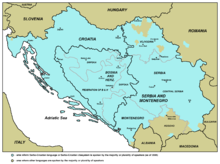Serbo-Croatian
Serbo-Croatian or Croatian Serbian (Serbo-Croatian srpskohrvatski or hrvatskosrpski or Cyrillic српскохрватски or хрватскосрпски) is a pluricentric language from the South Slavic branch of Indo-European languages. It is based on the štokavian dialect group in all its standard varieties. Its linguistic area includes present-day Croatia, Bosnia and Herzegovina, Montenegro and Serbia. In linguistics, the term Bosnian/Croatian/Serbian (B/K/S for short) is also used as an alternative. Colloquially, the term naš jezik (Serbo-Croatian for our language) or naški (ours) is commonly used to avoid an ethnic classification.
The term Serbo-Croatian was first mentioned in 1824 by Jacob Grimm in the preface to his translation of Vuk Stefanović Karadžić's Small Serbian Grammar. A few years later, in 1836, the term was used again by philologist Jernej Kopitar in a letter. Since the second half of the 19th century, Serbo-Croatian was the official common standard language of Serbs, Croats, Bosniaks and Montenegrins. This development was encouraged by the Austro-Hungarian authorities, but also partly rejected, especially by the Croats. In 1907, Bosnia became the first Balkan country to officially introduce the "Serbo-Croatian language" (srpsko-hrvatski jezik) as an official term in schools and public institutions. In the whole of Yugoslavia, this designation was not introduced until 1954, after the Novi Sad Agreement. After the break-up of Yugoslavia, Serbo-Croatian was still the official language of the Republic of Bosnia and Herzegovina from 1992 to 1995, before the relevant language standards diverged here, as in the other successor states, for politically motivated reasons, which was underlined by the consistent use of the independent designations Croatian, Serbian, Bosnian and Montenegrin.
The status of the standard varieties of Serbo-Croatian as independent languages is controversial in linguistics. While some authors assume slightly different realizations of a macrolanguage and thus a unified language system, others emphasize the dialectal differences and the necessity of a political will for unification, which currently does not exist. In sociolinguistics, the situation of the Serbo-Croatian language roughly corresponded to that of the English (English, American and Canadian variants) and German languages (German, Austrian and Swiss variants).

Approximate extent of the Serbo-Croatian language
Definition and glottonyms
Despite the current linguistic assessment of the problem, the term Serbo-Croatian is hardly used anymore, especially in Croatia and Serbia. In line with the variable use of the linguistic term, the internationally established glossonym has become a contested expression today. According to some linguists, it is a summary term for Bosnian, Croatian, Montenegrin and Serbian. It is disputed whether Serbo-Croatian is a language or a language subfamily. The written varieties of Serbo-Croatian are all based on forms of the štokavian dialect and agree in most of the grammar and vocabulary, but differ in other parts of the vocabulary, in many details of the linguistic norm, and in the use of different alphabets (in Croatian and Bosnian the Latin alphabet, in Serbian mainly the Cyrillic alphabet).
Whether they are varieties of a single language or four closely related languages in their own right is a matter of dispute both in linguistics (especially at chairs within the countries concerned) and among some speakers themselves. For example, the differences between Standard Serbian and Standard Croatian are much smaller than the differences between several Croatian dialects.
The alternative term Central South Slavic or Central South Slavic was coined by Dalibor Brozović in 1992 to replace the term "Serbo-Croatian", "compromised by a tortuous past". So far, however, it is mainly used by the latter himself, while linguistics sometimes uses the abbreviation B/K/S for Bosnian/Croatian/Serbian.
Serbo-Croatian as a subject of study
Many of the universities that have a Slavic Studies department also offer Serbo-Croatian alongside other Slavic languages. Sometimes the designation B/K/S (for Bosnian, Croatian, Serbian) or Croatian/Serbian is used for this, i.e. one language is assumed for which there are several designations.
Serbo-Croatian is offered as an independent subject at the following German universities (as of 2012): Hamburg, Göttingen, Gießen, Mainz, Heidelberg, Munich, Regensburg, Halle, Jena and Leipzig. As part of a general Slavic studies program, the language can be learned at the following universities: Bochum, Trier, Saarbrücken, Freiburg, Tübingen, Bamberg, HU Berlin and Cologne.
In Austria, Serbo-Croatian or B/K/S can be studied in Vienna and Graz, as well as in Innsbruck and Klagenfurt as part of a general Slavic studies programme.
Questions and Answers
Q: What is Serbo-Croatian?
A: Serbo-Croatian is a South Slavic language spoken in modern-day Croatia, Serbia, Bosnia and Herzegovina, and Montenegro.
Q: How has Serbo-Croatian been divided?
A: After the breakup of Yugoslavia, it has been divided into four variants.
Q: What dialect does Serbo-Croatian originate from?
A: The variants of this language are all based on a single dialect, Shtokavian.
Q: Are speakers of the different variants able to understand each other?
A: Yes, speakers of these variants all understand each other.
Q: Where is Serbo-Croatian spoken today?
A: Serbo-Croatian is spoken in modern-day Croatia, Serbia, Bosnia and Herzegovina, and Montenegro.
Q: How many variants are there of the language?
A: There are four variants of the language.
Search within the encyclopedia